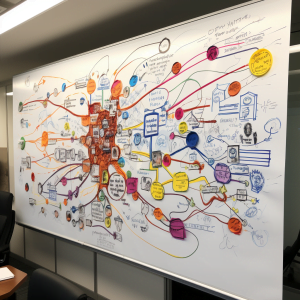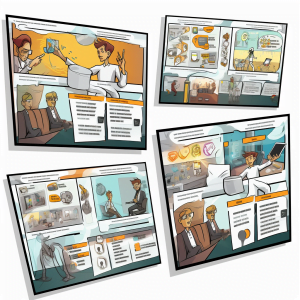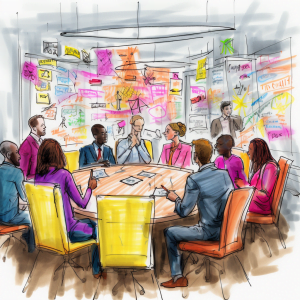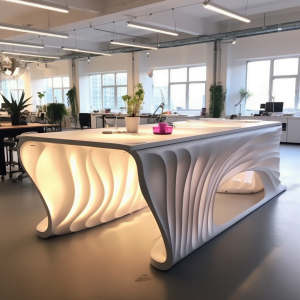Over the course of the previous three posts, we’ve embarked on a deep dive into the world of Design Thinking. We’ve traversed the initial stages, building a foundation of understanding and empathy towards the end-user’s perspective, establishing a clear problem definition based on our insights. We’ve explored how the Empathise and Define stages set the stage for the creation of effective, user-centric solutions.
Lets start Harnessing Ideate Power
As we continue our journey, we now arrive at the third stage of Design Thinking: Ideate. This critical stage leverages the groundwork laid in the preceding stages to generate innovative solutions. The Ideate stage is where creativity truly shines, as it encourages the generation of a broad spectrum of ideas, unhampered by constraints or limitations.
Where is Ideate in Design Thinking?
The Ideate stage is not a standalone process, but rather a core component in the overall Design Thinking journey. The insights drawn from the Empathise and Define stages fuel the ideation process, with user needs and problem definitions serving as the catalyst for innovative solutions.
Let’s dive in
As we delve deeper into the Ideate stage in this post, remember the crucial role it plays in the Design Thinking process. The Ideate stage is the bridge between understanding user needs and transforming these insights into tangible, innovative solutions. Having set the stage, let’s explore in more detail the power and process of Ideation.

The Ideate Stage: A look into its Importance and Process
Why do you need to Ideate?
Ideation stands as a critical phase within the Design Thinking process. It is during this stage that we break free from constraints and allow our creativity to flow, generating a myriad of innovative solutions. Ideation leverages the gained insights from the previous stages, transforming understanding and empathy towards the user into tangible ideas. Its importance stems from its role as the source of problem-solving, pushing the boundaries of conventional thinking and encouraging a solution-oriented mindset.
What is the Ideate Process?
The Ideate process can be broken down into a series of steps.
- Firstly, we gather the insights gleaned from the Empathise and Define stages, ensuring a solid foundation based on user needs and problem definition.
- Next, we engage in intensive brainstorming sessions, encouraging free thinking and the sharing of ideas.
- Following this, we collate and record the ideas, allowing us to visually map out our thoughts.
- Finally, we carry out an initial screening to identify the most promising solutions, considering feasibility and alignment with user needs.
How do we make it work?
To effectively implement the Ideate process, it’s vital to foster an environment that encourages creative thinking. Encourage team members to put forward any and all ideas, no matter how outlandish they may seem. Remember, it is through exploring the wildest of ideas that truly innovative solutions emerge. Experiment with different ideation tools and techniques such as mind mapping or storyboarding to facilitate the process. Finally, ensure you maintain a user-centric focus throughout, continually referring back to the user needs and insights identified earlier in the Design Thinking process.
It is through exploring the wildest of ideas that truly innovative solutions emerge
The Ideate stage is a phase that necessitates a free flow of ideas, driven by a deep understanding of user needs. The success of this stage lies in effective ideation, and its successful implementation can be the difference between generating good ideas and truly great ones. As we move forward, we’ll delve into some specific tools that can aid us in the Ideation process, further equipping us to harness the power of Ideate.

Harnessing Ideate Power: Brainstorming, Mind Mapping, and Storyboards
As we venture further into the Ideate stage, it’s essential to equip ourselves with the right tools to effectively generate and explore ideas. Some popular and effective tools for ideation are brainstorming, mind mapping, and storyboarding. Lets look into them and how they help.
Brainstorming
This is a tool that encourages the free flow of ideas without any inhibitions. It’s a process where a group of individuals come together to generate a plethora of ideas, where no idea is considered too outlandish or dismissed in the initial stages. The purpose is to encourage maximum idea generation, fostering a creative environment where innovative solutions can be born. It’s a powerful tool to harness ideation power, as it promotes divergent thinking, pushing boundaries beyond conventional ideas.
How to Brainstorm Effectively
Brainstorming is an invaluable tool in the Ideate stage, but just like any other tool, it needs to be used effectively to yield optimal results. Here’s a step-by-step guide on how to carry out a successful brainstorming session:
- Set the Stage: Start by setting a clear problem statement, derived from the insights from the Empathise and Define stages. This statement will serve as the focus for idea generation.
- Assemble Your Team: Gather a diverse team. Diversity encourages a wide range of perspectives and enhances the potential for innovative ideas.
- Set Rules: Make it clear that all ideas are welcome and judgement or criticism are not allowed during the session. This fosters an open environment for creativity to thrive.
- Idea Generation: Encourage free-thinking and let the ideas flow from all team members. Record all ideas, no matter how unconventional they may seem.
- Organise Ideas: Once the brainstorming session concluded, categorise the generated ideas based on their relevance and feasibility. This brings structure to the creative chaos.
- Refine and Evaluate: Lastly, refine and evaluate the ideas. Combine similar ideas, eliminate those that aren’t feasible, and select those that are most promising for further exploration and development.
Remember, the key to effective brainstorming is creating an open, non-judgemental environment that encourages the free flow of ideas. It’s about pushing boundaries, taking risks, and exploring the realm of possibilities.
Mind Mapping
Mind Mapping, on the other hand, is a visual tool used to structure and analyse the ideas generated. It involves creating a central node and associating it with related sub-nodes, representing ideas and their sub-ideas respectively. This technique enables us to see the bigger picture, establishing connections between different concepts and providing a comprehensive view of the problem and potential solutions. Mind mapping serves as an effective tool during the ideate stage, allowing for the visualisation of ideas in a structured, yet creative manner.

How to Use Mind Mapping
Mind mapping is a simple, yet powerful technique that can significantly enhance the ideation process. Here’s a step-by-step guide to creating an effective mind map:
- Identify the Central Idea: Start with the central idea or problem statement that’s serving as the focus of your brainstorming session. Write it down in the middle of your workspace.
- Generate Sub-ideas: Think about the major categories or sub-ideas that relate to your central idea. These could be potential solutions, factors contributing to the problem, or related concepts. Write these around your central idea, connecting them with a line.
- Explore Further: For each sub-idea, think about further related ideas or subtopics. Connect these to the appropriate sub-idea in the same way.
- Visualise Connections: Use lines, arrows, or colours to indicate relationships between different ideas. This can help to visualise links and dependencies.
- Review and Refine: Once you’ve created your basic mind map, take some time to review it. Look for gaps, redundancies, or potential improvements. It’s also helpful to share it with others for their input.
In the context of brainstorming, mind mapping can be used to capture and organize the ideas generated during the session. Each idea can be broken down into sub-ideas or related concepts, providing a deeper understanding of the problem and potential solutions. Not only does this help to keep the brainstorming session organized and focused, but it also provides a visual representation of the ideation process, making it easier to identify promising ideas and areas for further exploration. Moreover, mind mapping can foster further creativity, spurring more ideas as connections are visualised between different concepts.
Storyboards

Storyboards offer a sequential visual description of a user’s journey through a problem scenario, and how the proposed solution can address it. They help us to visually tell the story of a user’s experience, detailing each step of the process. Storyboards bring a narrative element to the ideation process, which can make the solution more tangible and easier to understand for all stakeholders involved.
How to Create Storyboards
Creating a storyboard in the ideate phase is a straightforward yet potent process. Here’s a step-by-step guide on how to create an effective storyboard:
- Define the Problem: Identify the central problem statement or user scenario you want to address. This should be based on the problem statement and insights from the Empathise and Define stages, as well as the ideas generated during the brainstorming session.
- Sketch the User Journey: Draw a series of panels representing the user’s journey through the problem scenario. Start with the current state, go through the steps the user takes, and end with the desired state where the problem is solved.
- Add Details: Fill in each panel with sketches, notes, and dialogue to describe what’s happening. This can be simple sketches or stick figures, and the focus is on conveying the idea, not artistic skill.
- Indicate Transitions: Use arrows or notes to indicate how the user moves from one step to another. This helps to clarify the flow of the user’s journey.
- Review and Refine: Once your storyboard is complete, take some time to review it and refine it as necessary. It can be beneficial to get feedback from others at this stage.
In the context of brainstorming and mind mapping, storyboarding can help to visualise the application of the ideas generated. It can show how a concept or solution would work in a real-world scenario, making it easier to understand and evaluate. The visual nature of storyboarding, much like mind mapping, encourages creative thinking and can lead to further idea generation.
Storyboard Usage in Brainstorming and Mind Mapping
Storyboarding is often used in conjunction with brainstorming and mind mapping to bring ideas to life. During a brainstorming session, several ideas are generated which can be visually structured and analysed using mind maps. Storyboarding takes this one step further by providing a pictorial sequence of the user’s journey using the proposed solution.
The ideas generated in a brainstorming session can be depicted in the panels of the storyboard, showing how they address the problem scenario. Similarly, the sub-ideas and connections identified in the mind map can guide the creation of the storyboard, providing a structured approach to the user’s journey. This integrated usage of brainstorming, mind mapping, and storyboarding can lead to a deeper understanding of the problem and more innovative solutions.
The Ideate stage, filled with creativity and innovation, is fuelled by the tools we employ to organise and illuminate our thoughts. Brainstorming, mind mapping, and storyboarding each bring unique perspectives and benefits to the ideation process, and their combined use can significantly enhance the quality of solutions generated. As we transition into expert opinions in our next section, take a moment to reflect on these tools and think about how they can be integrated into your Design Thinking process. For an extended list of tools and techniques, feel free to revisit our previous post, Design Thinking in Practice.
Expert Insights: Harnessing the Power of Ideation
Many industry leaders and innovators have harnessed the potential of the Ideate stage in Design Thinking to drive progress and success. Let’s delve into their insights:
“Ideas are like rabbits. You get a couple, learn how to handle them, and pretty soon you have a dozen.”
Tom Kelley, IDEO Partner
Tom’s perspective emphasises the exponential growth of ideas once you understand how to nurture and manage them. It underlines the importance of mastering techniques like brainstorming, mind mapping, and storyboarding in the ideation process.
“Don’t think about how quickly you can finish, but how much you can discover.”
Tim Brown, Executive Chair of IDEO
Brown reminds us that the value of the Ideate stage lies not in speed but in uncovering new perspectives and innovative solutions.
“Fail early to succeed sooner.”
David Kelley, Founder of IDEO and d.school
This quote encapsulates the iterative nature of ideation. By exploring a wide array of ideas, even those that might fail initially, we can identify effective solutions faster.
“Innovation distinguishes between a leader and a follower.”
Steve Jobs, Co-Founder of Apple
Jobs emphasises how innovative thinking, a key outcome of the ideation phase, is a significant differentiator in leadership.
“The best way to predict the future is to create it.”
Linda Naiman, Founder of Creativity at Work
Naiman’s quote underscores the importance of being proactive and using ideation to shape our own narrative.
“If I had asked people what they wanted, they would have said faster horses.”
Henry Ford, Founder of Ford
Ford’s famous quote highlights the importance of thinking beyond the obvious and the conventional during the Ideate stage.
These expert insights underscore the inherent value of the Ideate stage in Design Thinking. By cultivating a rich array of ideas and being open to exploration and failure, we can unearth innovative solutions that otherwise might have remained hidden.

Harnessing the Power of Ideation: Real-Life Examples
Example 1: Uber
Setting the Context: The idea for Uber was born when its founders were unable to hail a taxi in Paris. They saw a problem – the difficulty in finding a reliable, convenient ride – and the opportunity for a solution.
Ideate in Action: They started brainstorming solutions, and the idea of a mobile app for hailing cars was born. They continued to expand and refine this idea through further brainstorming sessions, creating the global ride-sharing platform that we use today.
Lessons Learned: Uber shows that a common problem can lead to a revolutionary idea. The ideation phase allowed the founders to explore various solutions, ultimately leading to an innovative and disruptive business model.
Example 2: Google Maps
Setting the Context: In the early 2000s, finding your way around a city or looking up directions was a daunting task. Recognising this issue, a small Sydney-based start-up, Where 2 Technologies, began developing a web-based map. Google, always on the lookout for breakthrough ideas, acquired the start-up and put a team to work on the project.
Ideate in Action: The team applied the Ideate stage by challenging conventional mapping systems. They brainstormed and introduced unique interactive features like drag-and-drop routes and location bookmarks. They further expanded on the idea, incorporating satellite imagery and street views to provide a comprehensive and dynamic mapping tool.
Lessons Learned: Google Maps revolutionised the way we navigate our world, showing how the ideation process can transform a simple concept into a solution that impacts millions worldwide. It emphasised the importance of challenging the status quo and thinking beyond conventional solutions.
Example 3: Instagram
Setting the Context: Instagram, today a photo-sharing giant, started as Burbn, a location-based check-in app. Kevin Systrom, the founder, realised that people were more interested in sharing photos than checking in.
Ideate in Action: Systrom and his team took this insight and brainstormed how they could pivot Burbn. They decided to focus on one feature, photo sharing, and do it exceptionally well. This led to the creation of Instagram, a platform that radically changed the way we share our lives.
Lessons Learned: Instagram’s story shows the power of observing user behaviour and re-orientating your idea accordingly. The Ideate stage provides the flexibility to adapt and evolve an idea based on these insights.
Example 4: PepsiCo’s Lay’s
Setting the Context: Lay’s, a leading brand of PepsiCo, noticed a growing trend towards healthier eating and a declining interest in traditional potato chips.
Ideate in Action: Lay’s launched ‘Do Us a Flavor’ campaign, asking consumers to suggest new chip flavours. The campaign not only involved consumers in the product development process but also helped Lay’s create unique flavours that resonated with local tastes.
Lessons Learned: Lay’s ‘Do Us a Flavor’ campaign highlights the Ideate stage’s importance in creating innovative, customer-centric solutions. This demonstrates the power of engaging customers directly in ideation and product development.

Example 5: UK’s GovTech Stack
Setting the Context: Driven by a need to improve public services and minimise inefficiencies, the UK government started a series of digital transformation initiatives.
Ideate in Action: The ideate stage was marked by extensive brainstorming sessions, stakeholder consultations, and user research. This led to the creation of the GovTech Stack, a unified digital platform that hosts multiple government services, making them accessible to citizens in one place.
Lessons Learned: This transformation initiative not only led to improved public service delivery but also fostered a culture of innovation within the public sector, demonstrating that ideation and creative problem-solving aren’t limited to the private sector.
Example 6: NYC’s 311 Service
Setting the Context: New York City faced a challenge managing non-emergency city services, with numerous hotlines leading to confusion and inefficiency.
Ideate in Action: During the ideation process, the concept of a single, easy-to-remember three-digit line for all non-emergency city services was born. This resulted in NYC’s 311 service, which citizens can call to obtain information, make complaints, or request city services.
Lessons Learned: NYC’s 311 service exemplifies the power of ideation in streamlining processes, improving service delivery, and enhancing citizen satisfaction.
Example 7: Estonia’s e-Residency
Setting the Context: Estonia, a small country in Northern Europe, sought to increase its economic growth and global influence by harnessing digital technology. Recognising the growing trend of digital nomadism, Estonia wanted to attract foreign entrepreneurs and freelancers.
Ideate in Action: The government initiated brainstorming sessions and explored the idea of creating a digital residency programme. This led to the development of the e-Residency programme that allows anyone in the world to start and manage a business in Estonia online.
Lessons Learned: Estonia’s e-Residency programme demonstrates the power of innovative thinking and ideation in addressing economic challenges. It shows how digital transformation can open new avenues of growth and influence, even for smaller nations.
Example 8: U.S. Air Force’s X-37B Space Plane
Setting the Context: The U.S. Air Force’s X-37B space plane program required a spacecraft that could demonstrate reusable flight, testing, and operations in low Earth orbit. The challenge was to develop a system that could adapt to various missions with minimalist changes.
Ideate in Action: The ideate phase involved brainstorming sessions, prototyping, and simulations. The team came up with the idea of a reusable, unmanned spacecraft that could be flown multiple times into space with a payload bay for modular experiments.
Lessons Learned: The X-37B program showcases the power of ideation in creating flexible, reusable technology that has the potential to revolutionise space missions. It underlines the importance of adaptability and forward-thinking in the design thinking process.
Example 9: British Army’s Project THESEUS
Setting the Context: The British Army sought ways to improve the logistical resupply process in challenging and often dangerous environments. The traditional supply chain model posed significant risks and inefficiencies.
Ideate in Action: Project THESEUS was born out of the ideation stage, envisaging an autonomous system to deliver supplies. The concept included using unmanned air and ground vehicles to ensure a consistent supply chain, reducing the risk to personnel and increasing efficiency.
Lessons Learned: The ideation process in Project THESEUS demonstrates how innovative thinking can streamline processes and enhance safety in high-risk environments. It highlights the power of design thinking to disrupt conventional models and drive efficiencies.
Example 10: Israeli Defence Forces’ Tunnel Detection System
Setting the Context: Security has always been a critical concern for Israel. The challenge was to find an effective solution to detect and neutralise the threat posed by underground tunnels used by adversaries.
Ideate in Action: During the ideate phase, the IDF engineers brainstormed and developed a unique solution – a sophisticated tunnel detection system that uses seismic sensors to detect underground activities. This groundbreaking technology has significantly enhanced Israel’s security apparatus.
Lessons Learned: The IDF’s tunnel detection system is a testament to the power of ideation in addressing complex security issues. It underscores the role of innovative thinking and technological advancement in national security.
In conclusion, these examples provide a vivid illustration of the transformative power of ideation in a multitude of sectors, from technology and public services to defense and space exploration. Each example offers a unique perspective on how the Ideate stage of the design thinking process can be harnessed to create innovative, customer-centric solutions that address complex challenges. By embracing ideation, organisations like Lay’s, the UK government, the NYC’s 311 service, the Estonian government, U.S. Air Force, British Army, and Israeli Defense Forces have been able to generate groundbreaking ideas that have helped transform their services, products, or infrastructure. As readers and potential innovators, these examples underscore the importance of engaging in expansive thinking, leveraging collaboration, and prioritising customer needs to generate effective and innovative solutions to the challenges you face. Harness the power of ideation, and you too can drive transformative change within your sphere of influence.
What’s Next in Design Thinking?
As we transition from the ‘Ideate’ stage, we prepare to delve into the next pivotal stage of the Design Thinking process – ‘Prototype’. This phase is inherently linked to ‘Ideation’, serving as the physical manifestation of the ideas generated. It is during this stage that the abstract becomes tangible, offering us a first glimpse of the potential solution in its practical form. Prototyping allows us to visualise, test and refine our ideas further, bringing us one step closer to a viable solution.
Our exploration of the Ideate phase has shed light on its transformative power in driving innovation across multiple sectors. It has underlined the significance of expansive thinking, collaborative brainstorming, and customer-centric approaches in generating innovative and effective solutions. As we move into the Prototyping stage, we carry with us the insights gained and the ideas born from the Ideate stage. The journey through the Design Thinking process continues to be as intriguing as it is enlightening. Stay tuned as we uncover the intricacies of the Prototyping stage in our upcoming post – ‘Harnessing the Power of Prototyping in Design Thinking’.
References and Further Reading
- IDEO: A global design company committed to creating positive impact and a pioneer in Design Thinking.
- d.school: Institute of Design at Stanford: A hub for innovation, collaboration, and creativity at Stanford.
- Creativity at Work: Linda Naiman’s organisation that provides services to help individuals and organisations innovate.
- Harvard Business Review – Design Thinking: Article discussing the role of Design Thinking in driving innovation in organisations.
- The Art of Innovation by Tom Kelley: A book detailing IDEO’s process of fostering innovative thinking.
- Change by Design by Tim Brown: Tim Brown introduces the idea of Design Thinking, the collaborative process by which the designer’s sensibilities and methods are employed to match people’s needs.
- Innovator’s Dilemma by Clayton M. Christensen: This book explores how successful companies can do everything “right” and still lose their market leadership.
- Brown, T. (2008). Design Thinking. Harvard Business Review.
- Ries, E. (2011). The Lean Startup: How Today’s Entrepreneurs Use Continuous Innovation to Create Radically Successful Businesses. Crown Business.
- US Air Force. (2020). X-37B Orbital Test Vehicle.
- Ministry of Defence, British Army. (2018). Project THESEUS.
- Israeli Defense Forces. (2020). Tunnel Detection System.
- Kolko, J. (2015). Design Thinking Comes of Age. Harvard Business Review.
- Kelley, T., & Kelley, D. (2013). Creative Confidence: Unleashing the Creative Potential Within Us All. Crown Business.
- Seidel, V. P., & Fixson, S. K. (2013). Adopting Design Thinking in Novice Multidisciplinary Teams: The Application and Limits of Design Methods and Principles. Journal of Product Innovation Management.
- Warfield, J. N. (2006). Understanding Complexity: Thought and Behavior. AJAR Publishing Company.
- Design Thinking: Get Started with Prototyping – Interaction Design Foundation
- Harnessing the Power of Ideation and Brainstorming – Forbes
- Estonia’s E-Residency Programme – Government of Estonia
- U.S. Air Force’s X-37B Space Plane Program – Air Force Technology
- Project THESEUS: British Army’s Autonomous Resupply – Army Technology
- Israeli Defense Forces’ Tunnel Detection System – The Jerusalem Post
For a deeper dive into Design Thinking and the power of Ideation, the books and resources mentioned above offer a wealth of knowledge, insights, and practical applications.
Please note that these resources lead to external sites. While we ensure the links are accurate at the time of publication, we cannot control the content or availability of the linked pages.





0 Comments